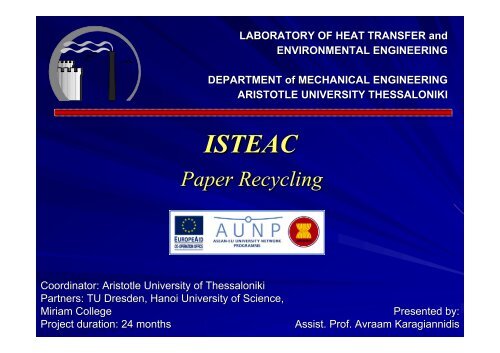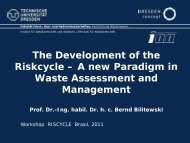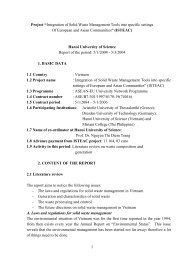Visualization - wadef
Visualization - wadef
Visualization - wadef
You also want an ePaper? Increase the reach of your titles
YUMPU automatically turns print PDFs into web optimized ePapers that Google loves.
LABORATORY OF HEAT TRANSFER andENVIRONMENTAL ENGINEERINGDEPARTMENT of MECHANICAL ENGINEERINGARISTOTLE UNIVERSITY THESSALONIKIISTEACPaper RecyclingCoordinator: Aristotle University of ThessalonikiPartners: TU Dresden, Hanoi University of Science,Miriam CollegeProject duration: : 24 monthsPresented by:Assist. Prof. Avraam Karagiannidis
ContentsPaper and paperboard market worldwide.Recovered paper worldwide.Paper and paperboard market in Europe.Recovered paper in Europe.The Hellenic paper and paperboard market.Paper recycling projects in Greece.Conclusions.
Paper Issues Worldwide
1. Paper and board market worldwide1201980 1990 2000 2001 2002Production (Mt)100806040200WestEuropeNorthAmericaLatinAmericaAsiaHistorical data shows that significant growth on paper productiontook place in Asia (roughly 80%, between 1990-2002).The production of paper and board in Western Europe increasedby more than 1/3 during 1990-2000.Source: CEPI, 2003
2. History of paper and board net tradePaper and cardboard (Μt)151050-5-10-151980 1990 2000 2001 2002WestEuropeNorthAmericaSouthAmericaAsiaEurope is the largest paper and board exporting area in the world.The European Industry increased its exports of paper and board by b75% between 1990-2000, which represents the most positiveevolution in the world.In 2002, more than 12 Mt were exported.Source: CEPI, 2003
3. Recovered paper trade flows in 2002The internationalrecovered paper tradewas 26 Mt in 2002.The most importanttrade flows were: between Europeancountries, from USA to Asia, from Europe toAsia, between Asiancountries, from USA toCanada andMexico.
4. . Recovered Paper (Utilisation, Collection andRecycling) ) comparisoncamong Regions in 2002Recovered paper (%)7065,359,956 59,6 59,66055,557,952,750 47,5 47,9 4547,8 48 48 4837,8 39,538,8403020100EuropeNorth AmericaAsiaJapanLatin AmericaWorldwideUtilization Rate (%) Collection Rate (%) Recycling Rate (%)The European recycling rate is well above the North Americanlevel.USA should increase their collection activity to be able toincrease collection volumes and satisfy the growing Asianimport demand for recovered paper.Source: The European Declaration on Paper Recovery, Annual Report t 2003
5. Paper Recycling in USAIn 2003, 50,3% of the paper was recovered (1990: 33,5%).The total quantity of recovered paper amounted 49,3 Mt (in2003) (+3,4% from 2002 and +69% from 1990).Corrugated boxes and newspapers, were recovered 75% and73%, , respectively, in 2003.National GoalGoal: to recover 55% of all paper consumed inthe USAby 2012.In 2003, more than 85% of the Americans had access topaper recycling projects.China imported more about 6 Mt of US recovered paper in2003.While exports to South Korea, India, Japan and WesternEurope declined in 2004, China increased its purchases ofUS recovered paper by 8.8%.
Europe
1. IntroductionMain characteristic of the EU is the big differences among themember states with respect to:– the produced paper quantities,– demands of raw material, consumption,– collection and utilization of recovered paper.Although EU is net exporter of recovered paper, it is netimporter of the chemical pulp.Pulp production in EU does not cover the demands for paperproduction.The demands of imported chemical pulp were 23% of the totaldemand of 31,2 Mt which is estimated to reach 34 Mt in 2020.
2. European paper and board marketProduction and consumptionYearProduction (Μt)Consumption (Μt)1991676220039585Paper and board productionis continuously increasing inEU, from 47Mt in 1885 to 95Mt in 2003.The total production isestimated to reach 115Mt in2020.Paper quantity (Kt)100908070605019901991199219931994199519961997ConsumptionYear1998199920002001Production200220032004Consumption wasroughly 89% ofthe production in2003.It is estimated toreach 90% of theproduction in2020.Source: CEPI, 2003
3. Recovered Paper Trade Balance by Country (kt)
4. Comments on the recovered paper tradebalance chartThe United Kingdom has emerged as the biggest net exporter ofrecovered paper, before Germany, which has seen newproduction capacity leading to higher utilisation of recoveredpaper.France is for the first time, in the category of net exporters, andItaly has dramatically reduced its deficit and is close to abalance.In Spain, Sweden and Austria the net imports of recovered papercontinue to increase.Greece is also among the countries that export recovered paper(62kt in 2003).Net exports of recovered paper amounted to 4.2 Mt in 2003compared to 3.8 Mt in 2002 (+10%).China remains the largest importer of European recovered paperbecause of huge investments in new paper recycling capacities.
5. Collection of recovered paperIn 2003 an extra 1.3 Mt (+2.8%) of recovered paper wascollected.Collection rate reached in a year 57.3% after 56.2% in 2002.Collection rate =Collection of recovered paperPaper and boardconsumptionAt European level, around 50% of the collected volumes comefrom trade and industry sources, 40% from households and theremaining 10% from offices.These proportions differ greatly between countries as well ascollection systems.In Finland, Germany, Sweden and the Netherlands, thecollection rate has been close or even beyond 70% for manyyears and these rates cannot be expected to increase largely.
6. Utilization of recovered paperRecovered paper utilization continued its steady increase; 700Mt or 1.6% in 2003.Utilization rate =Recovered paper utilizationTotal paper andboard productionAs production of paper and board (+2.1%) increased more thanutilization of recovered paper (+1.6%), the utilization ratereduced.Recovered paper utilization rates are very high in packaginggrades, e.g. 90% in case materials.Newsprint is also a big user of recovered paper: its utilizationrate of recovered paper has increased steadily over the yearsand reached 74% in 2003.
7. Paper recyclingThe recycling rate from 38,8% in 1990, reached 49,4% in1999 (+16 Mt).It registered an increase in 2003 reaching 53.2% after 52.8%in 2002.The European paper industry utilized an extra 700 Mt ofrecovered paper compared to 2002.The total amount of recovered paper that was recycled in2003 was 44.7 Mt.Recycling rate =Recovered paper utilizationTotal paper andboard consumption
CountriesAustriaBelgiumDenmarkFinlandFranceGermanyGreeceUtilizationrate (%)43,6%38,4%108,1%5,3%58,2%64,5%69,7%Collectionrate (%)62,0%53,4%53,1%72,9%54,4%73,7%33,3%Recyclingrate (%)97,8%19,4%29,0%66,9%53,3%67,2%28,2%Although Greece is amongthe countries with lowcollection and recycling rate(33.3% and 28.2%respectively), appears highutilization rate (69.7%).Ireland109,3%37,6%9,8%Italy56,0%47,0%47,5%Netherlands71,1%67,7%68,2%Portugal21,3%46,5%30,4%Spain81,7%50,5%61,6%Sweden17,4%67,6%87,4%United Kingdom72,851,1%36,3%Czech Republic41,0%43,6%33,0%Hungary68,3%55,9%52,4%Norway20,9%67,6%53,6%Poland38,4%37,3%33,4%Slovak Republic37,3%47,9%61,1%Switzerland58,3%69,9%65,6%TOTAL CEPI47,0%57,3%53,2%Source: CEPI, 2003
Evolution of the Recovered Paper Utilization and the RecyclingRate in CEPI countries 1991-2004.
Greece
1. IntroductionGreece is among the EU countries with low paper and boardproduction and consumption.The collection and recycling rates are also low.Greece is a net importer of paper and board products andduring the last years small amounts of recovered paper wereexported (62kt, 2003).In 1998, 250 kt of recovered paper were collected, while in2003 the collection reached 407 kt.The Hellenic paper industry consists of 151 enterprises and8,350 employees; 14 of them are papermills.
Paper mills inGreece andtheir production(t/day)
2. Paper and board trade balance in GreecePaper and board quantities(Kt/y)9008007006005004003002001000505 500 480450510690790 78035 40 43 50 461986 1990 1994 1998 2003Year490Annual production Annual imports Annual exports495
3. Paper imports in GreeceThe increased paper demands are covered through extraimports from other countries.Data from the NationalStatisticalServiceof Greeceshowed that 80% of the paper and board imports come from EU countries(Germany (12%), Italy(19%), Finland (13%), the Netherlands). 1990-1998: 1998: imports of paper quantities were increasing withan average annual rate of 8%. 1993-1999: 1999: imports of paper pulp were increasing with anaverage annual rate of 9.2%. In 2000, pulp imports amounted 122,046 t (Main suppliers:Russia, Morocco, Canada, USA and Sweden).
4. Consumption and collection in GreecePaper and board quantities(kg/capita)12510075502501986 1990 1994 1998 2003YearConsumptionCollection of recovered paperAnnual collection andutilization of recovered paperRecovered paperquantities (kg/capita)Annual paper consumptionand annual collection ofrecovered paper40353025201510501986 1990 1994 1998 2003CollectionYearUtilization
5. History of paper recycling in GreeceRecovered paperquantities (Κt)4003503002502001501005001991199219931994199519961997Data shows the weakness of the Hellenic paper industries toaccept an annual quantity of recovered paper more than 380 kt.The capacity of the domestic paper industries was alsodecreased due to the fact, that several paper industriesterminated their operation.1998Year19992000200120022003
6. Recent dataIn 2003:Hellenic paper and board production amounted 495 kt (+0.4%from 2002).145 kt were tissue paper and 350 kt were packaging paper(70kt board and 280 kt wrapping paper).No production of printing paper after the termination of anindustry’s operation with capacity 200t/day in Drama.Raw material used:345 kt of recovered paper.193 kt pulp.7 kt other.
Papermass flowin Greecefor 2003
7. Recycling projects in GreeceHellenic Recovery Recycling Corporation (HERRCO)Recycling projects: Athens, Patra, Zakinthos, Pieria(coverage650,000000 residents).New projects by 2007: Thessaloniki, Lamia, Kalamata, Trikala,Karditsa, Heraklion, Corfu, Chania (coverage1,500,000000 residents).Recycling projects in Athens (HERRCOand Association of Communitiesand Municipalities in the Attica Region (ACMAR)2 projects for 2,350,000000 residents of 71 local authorities.It is estimated that in 2007 the collected paper quantities will beincreased by 30% (by optimising the collection systems and usingmore bins).Recycling projects in Thessaloniki (Association of Local Authoritiesof the Greater Thessaloniki Area and Municipality of Thessaloniki)2 projects for 1,000,000residents.It is estimated that in 2007 the collected paper quantities will beincreased by 20% (co-operation operation between the Association andHERRCO, more bins).
7.1 Hellenic Recovery Recycling Corporation (HERRCO)Current situation (2005)(2007)
7.2 Paper Recycling Projects in Athens (HERRCO(& ACMAR)Current situation (2005)(2007)
7.3 Paper Recycling Projects in Thessaloniki (HERRCO(& ACMAR)Παρούσα κατάσταση (2005)Πρόβλεψη (2007)
7.4 Future of Paper Recycling Projects (from HERRCO) in GreeceNumber of recyclingprojects353025201510502005 2007 2015 2025YearFuture plans forrecycling projects inGreece.Future plans forpopulation coveragefrom recycling projectsin Greece.Population(10 3 residents)1200010000800060004000It is estimated that after2020, the annually collectedRP from these projects, willbe more than 400kt200002005 2007 2015 2025Year
7.5 Future of the Hellenic paper industriesAccording to the Hellenic Association of Paper Industries:The paper and board production is not expected to bedramatically increased.– The current situation (available equipment, lack of policyand lack of motives from the government) shows that it isdifficult to invest in order to increase the collection ofrecovered paper to be used in paper production.– It is estimated that the collected recovered paper will bemuch more than the domestic demand, thus, the morecollected recovered paper will be exported to othercountries (Turkey, Bulgaria, Italy) or used in applicationsoutside paper industries.
7.6 Future of Paper Recycling in GreeceQuantity (kt)60050040030020010002005 2010 2015 2020 2025 2030YearScenario 1 Scenario 2 ProductionA. Steady paper & boardproduction and 2scenarios on theincreased collection ofrecovered paper frompaper recycling projectsin Greece (optimistic andless optimistic scenarioof collection).B. Steady paper & boardproduction and 2scenarios on theincreased collection ofrecovered paper frompaper recycling projectsin Greece and steadycollection from papermerchants (375kt, 2003).Quantity (kt)10009008007006005004003002005 2010 2015 2020 2025 2030YearProduction RP Merchants Scenario 1 Scenario 2
8. Results – Europe (1/2)Paper & board market• Production increased more than 1/3 during 1993-2003.• It is estimated to reach 115 ΜtΜin 2020 from 95 ΜtΜin 2003.• Europe is the bigger exporter worldwide.• Europe exports recovered paper but imports significantamounts of chemical pulp.Collection of recovered paperCollection rate1985: 34% (15 Μt). Μ2003: 57% (48 Μt). Μ2020: 66% (68 Μt). Μ• Differences on the extent of collection among the countries ofCentral and North Europe and those from South.
8. Results – Europe (2/2)Utilization of recovered paperUtilization rate1985: 34% (16(Mt).2003: 47% (44,6 Mt).2020: 56% (64 Mt).• Increasing collection, the utilization of recovered paper is alsoincreased (and vice versa).Paper recycling• Recycling rate 53,2% το 2003.• EU target for the recycling rate: 60%, 2008.• EU targets: for packaging paper and board. No legislation inforce for printing and graphic paper.
9. Results – Greece (1/2)Paper & board market• Production1998: 515 kt.2003: 495 kt.• Paper & board imports1994: 690 kt.2003: 783 kt.• Greece exports recovered paper (62 kt in 2003).Collection of recovered paperThe collected amounts of paper have been increased due to theLaw 2939/01.• Collection rate1998: 22% (250 kt).2003: 33,3% (407 kt).• It is estimated that the collection rate will further be increaseded.
9. Results – Greece (2/2)Utilization of recovered paperUtilization rate1998: 56% (290 kt).2003: 69,7% (345(kt).Paper recycling• Recycling rate1991: 19,3% (116 kt).2003: 28,2% (345 kt).• 85% of the collected paper (407 kt) was recycled in 2003• According to the EU legislation for packaging waste, the target forpaper and board is: 15% recycling up to 2006.• No existing schemes for alternative uses of recovered paper(outside paper industries).
Thank you for your attention!




